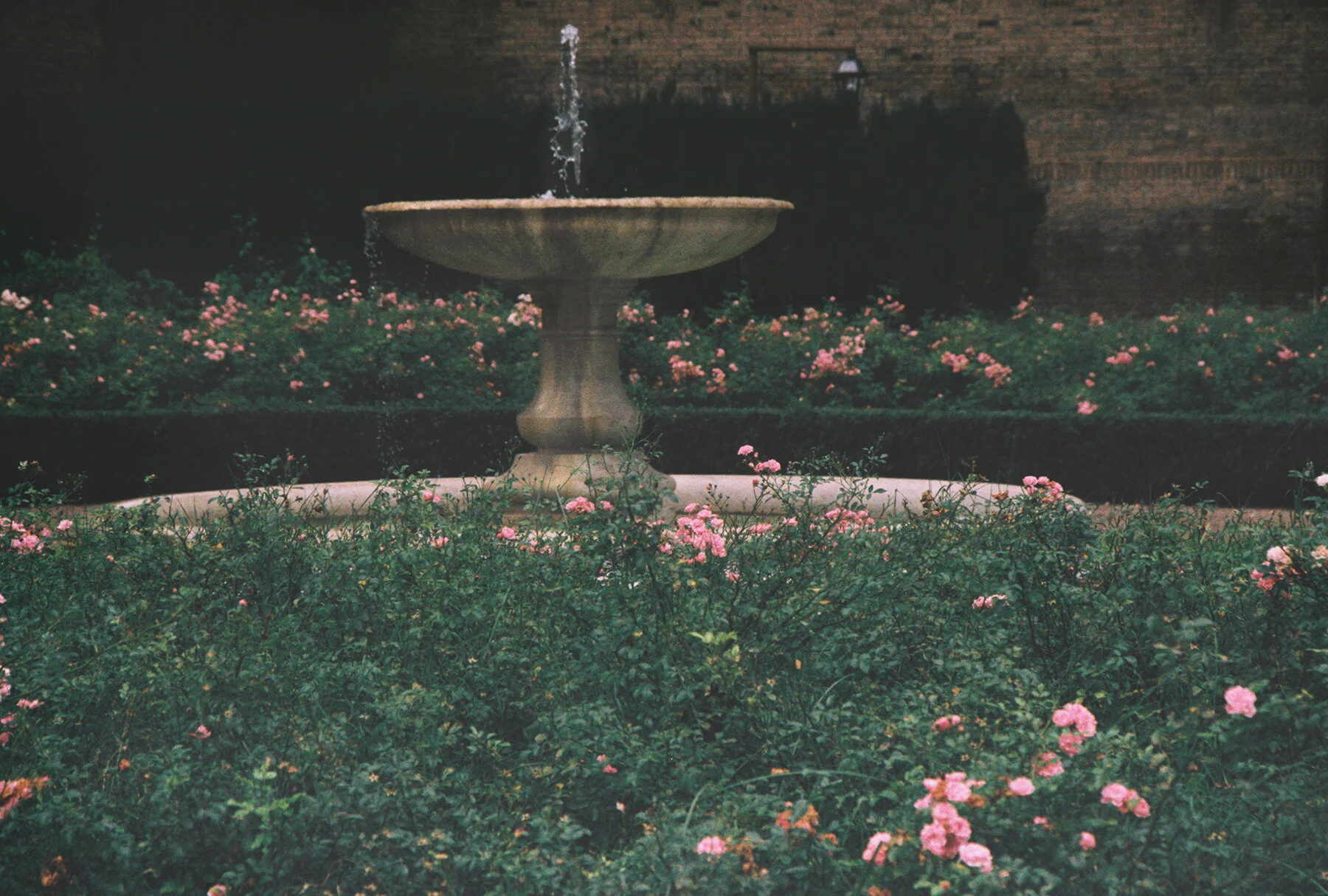The art and architecture at the Villa Farnesina / Rome
The flowers of the Renaissance garden decorate the pretty country style lanes and the fountains.
The Villa Farnesina is an early 16th century Renaissance suburban villa on the Via della Lungara, in the district of Trastevere in Rome, central Italy. It has incredible frescoes by Raphäel, Sebastiano del Piombo, Giulio Romano, and Il Sodoma. The villa was built for Agostino Chigi, a rich Sienese banker and the treasurer of Pope Julius II. It was later purchased by Cardinale Farnese (future pope and brother to the Borgia mistress, Giulia Farnese).
I had always missed visiting the lovely Villa Farnesina on earlier trips to Rome so I was delighted to finally see it in person in October 2012 with my late husband Rian. We were lucky enough to visit it a few times in the following years. This entry is from our first visit in 2012. I shot everything on vintage Ilford black and white film and vintage Portra color film on a vintage canon analog film.
I wrote about the garden in a recent photo & write up blog entry here.
The villa has a pretty little garden in the courtyard and larger gardens (fenced off) on one side. There is an understated elegance to the grounds and exterior architecture for a Renaissance palazzo. There are pink roses and pomegranate trees in clay pots and little lemon trees and stone lined pathways. Trastevere is a great neighborhood to visit when in Rome, and this villa is even more off the beaten path if you are looking for an alternative to the usual Roman Holiday Tour.
After the initial two or three visits to Rome we began to visit more of the quiet corners of the city and get to know our favorite spots better. It’s a “slow food” approach to travel that worked pretty well for us over many years visiting Italy, especially Rome and Campania and Florence.
The large grande dame museums of Rome are absolutely wonderful to visit, especially if you have limited time in the city. But if you have an extra day or the off the beaten path vacation is more your speed, I suggest visiting one, two or three small villa or palazzo art museums. Farnesina, Doria Pamphlij, Spada, Borghese (the Queen), and a few others.
The Loggia of Psyche by Raphaël and his workshop. It’s difficult to convey how astounding it is just standing on the marble floors, looking up at all the beautiful frescoes. Walking the same halls so many infamous and interesting figures had crossed centuries before. The museum is quiet and there were a few small groups moving in and out of the rooms at most when visiting. I always have time to view the work in complete silence and solitude, which rarely happens in a larger, more popular museum, even during the off seasons.
Venus, Ceres and Juno
I had run out of color film so I shot these magnificent frescoes in black and white. I think they at least capture the richness of the dark colors and the creaminess of the “skin”. The color in person was vibrant for such old masterpieces.
Cupid and The Three Graces, 1517-1518
A part of the great appeal Renaissance art has for me is it’s allusions to classical literature and mythology. In order to understand the works beyond my emotional response to them or my aesthetic pleasure in them, the allegorical works force me to learn the meaning behind them and catch a glimpse of the artist’s intention behind the work. What does the piece mean philosophically? Politically? What does it say about love? Man? And God? About life? And death? What historical event are they re-imagining? Beyond the beauty I am hungry for the history.
Raphael murals shot on vintage black and white Ilford film.
Venus on the Chariot Pulled by Doves, 1517-1518
The Council of the Gods, 1517-1518
Venus and Cupid, 1517-1518
When I was there I was amused to find graffiti carved into one of the walls in German! Well, normally I’d be less amused but it’s from a later “Barbarian Invasion” of Rome in the 16th century! At the time I couldn’t find anyone to translate it for me.
During recent restorations, an ancient “graffiti”, in German gothic, came to light between the columns. It marks the passage of the Lansquenets and states: “1528 – why shouldn’t I laugh: the Lansquenets have put the Pope to flight.”
From the windows on the first floor there is a beautiful view of the gardens.
Lemon trees are the quintessential jewels on the crown of Italy, even half ripened the golden yellow looks inviting, beckoning to be picked and savored.
Pomegranates grow in the lush green of bushes surrounding the historic property.
A pleasant stroll under the laurel bower leads to a marble plaque which bears the inscription:
Quisquis huc accedis: quod tibi horridum videtur mihi amoenum est; si placet, maneas, si taedet abeas, utrumque gratum.
[Trad.: Whoever enters here: what seems horrid to you is pleasant to me. If you like it, stay, if it bores you, go away; both are equally pleasing to me. ]
– Academia Nazionale die Lincei
The Villa Farnesina in Rome, Italy is open from
Monday to Saturday from 9 a.m. to 2 p.m.,
Closed on Sundays and holidays.
Guided tours on Monday, Friday and Saturday at 12.30.
See color photographs of the art murals of the Villa Farnesina art museum in this blog entry here. Worth a look, the murals are absolutely splendid in color! They were shot at a later visit, and really bring out the soft and vibrant tones of the renaissance paintings.








